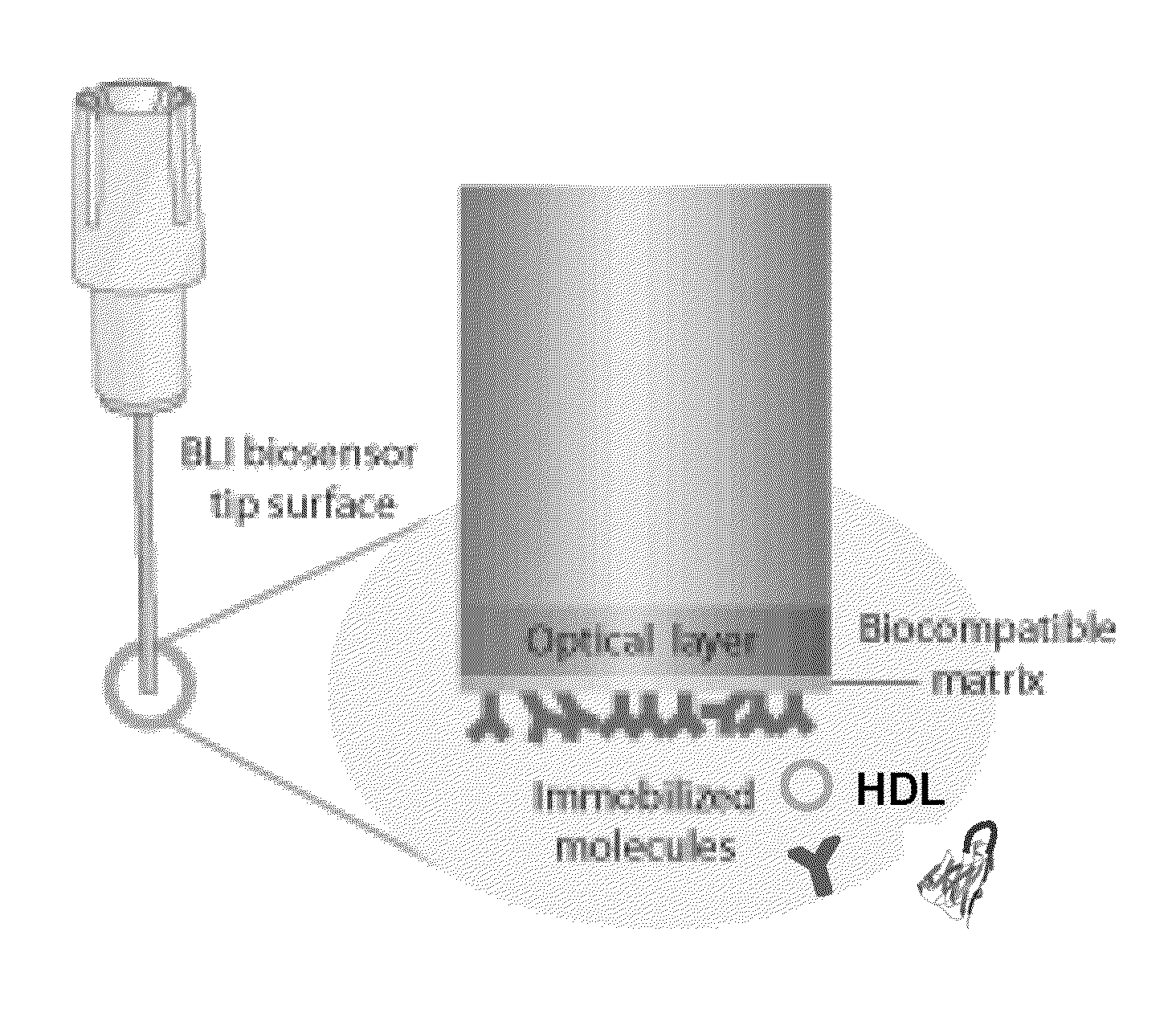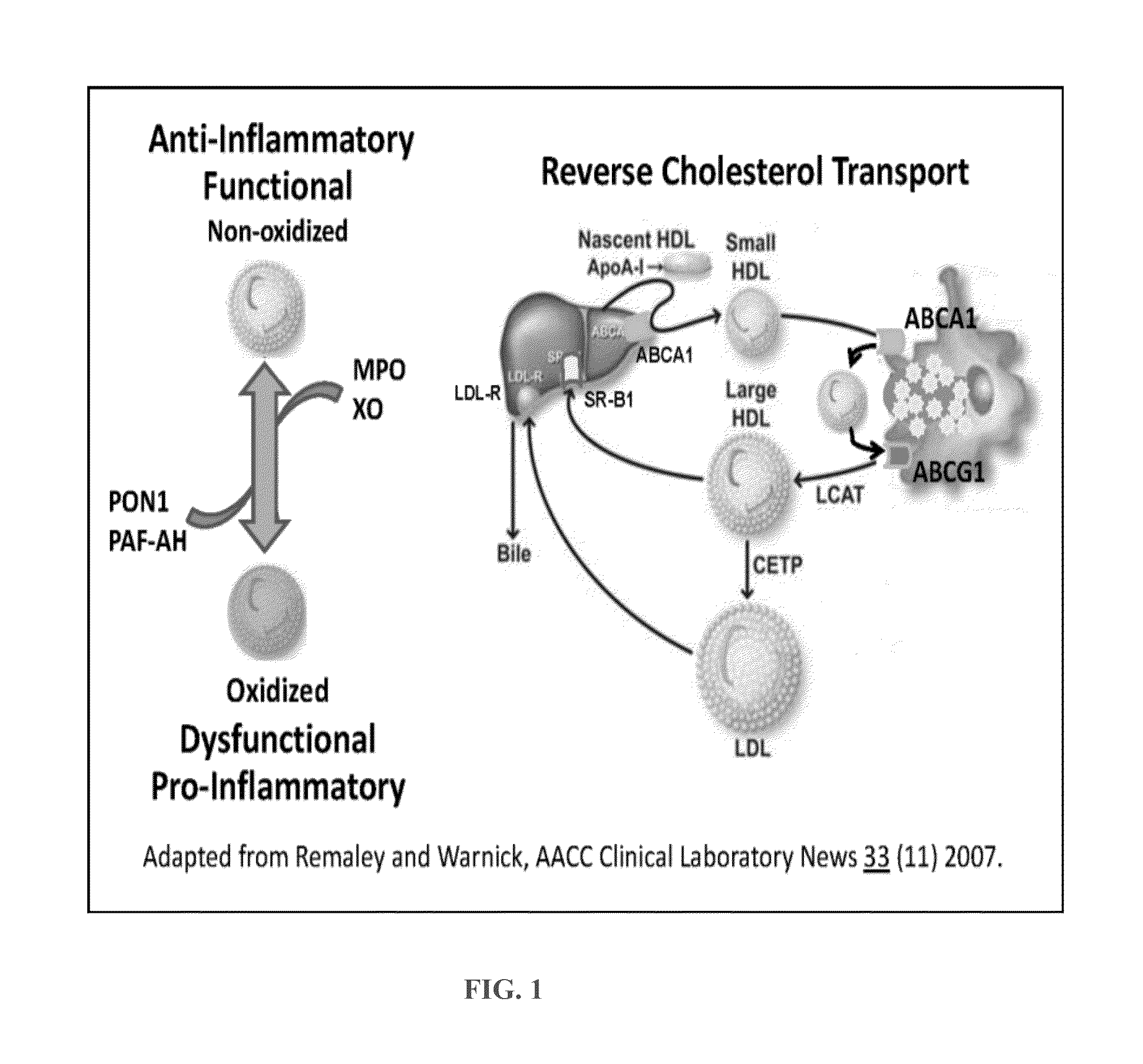Assays for hdl biomolecular interactions
a biomolecular interaction and assay technology, applied in the field of cell biology, molecular biology and therapeutics, can solve the problems of tissue infarction, ulceration and rupture, etc., and achieve the effects of improving drug development, assessing hdl function, and performing in a short time period
- Summary
- Abstract
- Description
- Claims
- Application Information
AI Technical Summary
Benefits of technology
Problems solved by technology
Method used
Image
Examples
example 1
[0166]HDL Binding Affinity for Native Biomolecules can be used as a Surrogate for HDL Function. Methods are disclosed herein, which challenge the current paradigm of patient care, by proposing a new way of quantifying HDL function. Assays that measure interactions between HDL and the biomolecules that are well known to mediate HDL metabolism are disclosed.
[0167]HDL binds a wide variety of biomolecules. Some interactions between HDL and biomolecules appear to be influenced by diseases driven by oxidative stress and inflammation. BLI assays were used to measure HDL / ApoA-I concentrations.
[0168]BLI assays of HDL interactions with biomolecules represent a novel approach for obtaining biologically relevant information about “HDL function.” If a change in HDL composition is pathophysiologically relevant, then it should alter the way HDL interacts with biomolecules that mediate HDL function.
[0169]Methods
[0170]BLI is a relatively new, label-free technique for measuring biomolecular interacti...
example 2
[0174]As HDL function is hypothesized to decrease with increasing oxidative stress, native HDL was incubated with HOCl under conditions that are reported generate ox-HDL (oxidized HDL), which is similar to that detected in vivo (Zheng L, et al., J Clin Invest. 2004; 114:529-541). The ability of the anti-ApoA-I-biosensors to bind n-HDL and ox-HDL was compared.
[0175]FIG. 5 shows that n-HDL and ox-HDL bind to the anti-ApoA-I biosensor at essentially the same rate. Thus, the biosensors detected ox-HDL as well as n-HDL, which is essential for developing an unbiased assay for measuring differences in binding affinity and / or rates of binding. The data presented in FIGS. 2-5 provide strong proof that biosensors capture n-HDL and ox-HDL equally well to detect structural differences.
example 3
[0176]After establishing that the ApoA-I biosensor detected and quantified n-HDL and ox-HDL equally well, an investigation was conducted to determine if n-HDL and ox-HDL exhibit any differences in binding affinity for PON1 (15 μg / mL).
[0177]Purified human HDL (1 mg protein / mL) was labeled with biotin. Streptavidin (SA) biosensors were incubated for 15 minutes in a standard solution of the biotin-labeled HDL. The HDL-coated SA biosensors were then incubated in 100 μM HOCL in PBS or PBS alone for 15 minutes followed by a PBS wash for 3 minutes. Finally, the non-oxidized and HOCL-oxidized HDL coated SA biosensors were incubated in solutions of PON1, MPO, CETP or the chimer camelid SR-B1 (amino acids 424-434 in SRB1) for 15 minutes and rates of protein binding determined by BLI.
[0178]FIG. 6 shows that that PON1 binding rates with ox-HDL were much faster than the rates at which it associates with native HDL, which is zero. These data are consistent with reports that PON1 binds ox-HDL to h...
PUM
 Login to View More
Login to View More Abstract
Description
Claims
Application Information
 Login to View More
Login to View More - R&D
- Intellectual Property
- Life Sciences
- Materials
- Tech Scout
- Unparalleled Data Quality
- Higher Quality Content
- 60% Fewer Hallucinations
Browse by: Latest US Patents, China's latest patents, Technical Efficacy Thesaurus, Application Domain, Technology Topic, Popular Technical Reports.
© 2025 PatSnap. All rights reserved.Legal|Privacy policy|Modern Slavery Act Transparency Statement|Sitemap|About US| Contact US: help@patsnap.com



